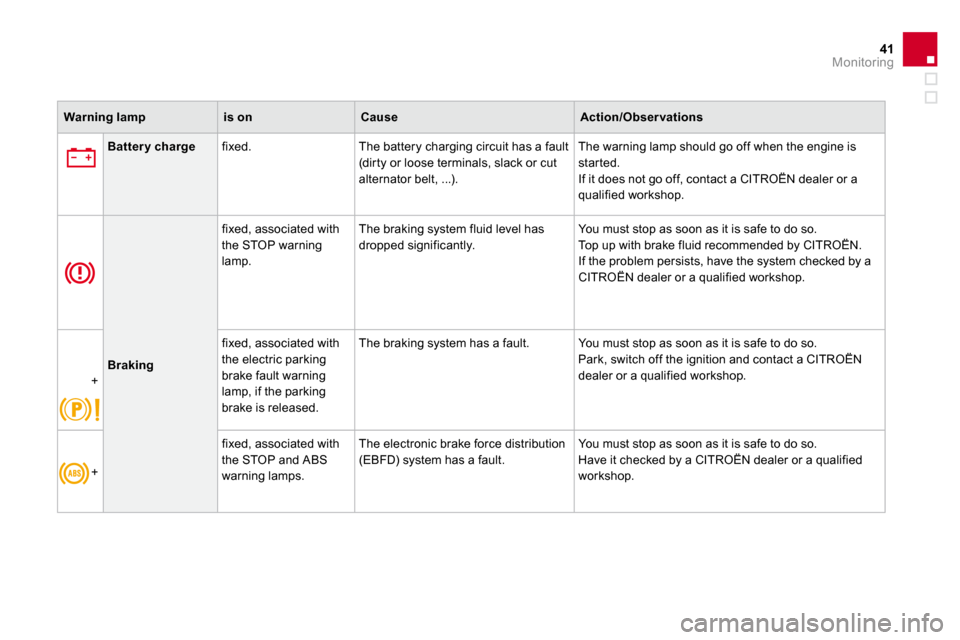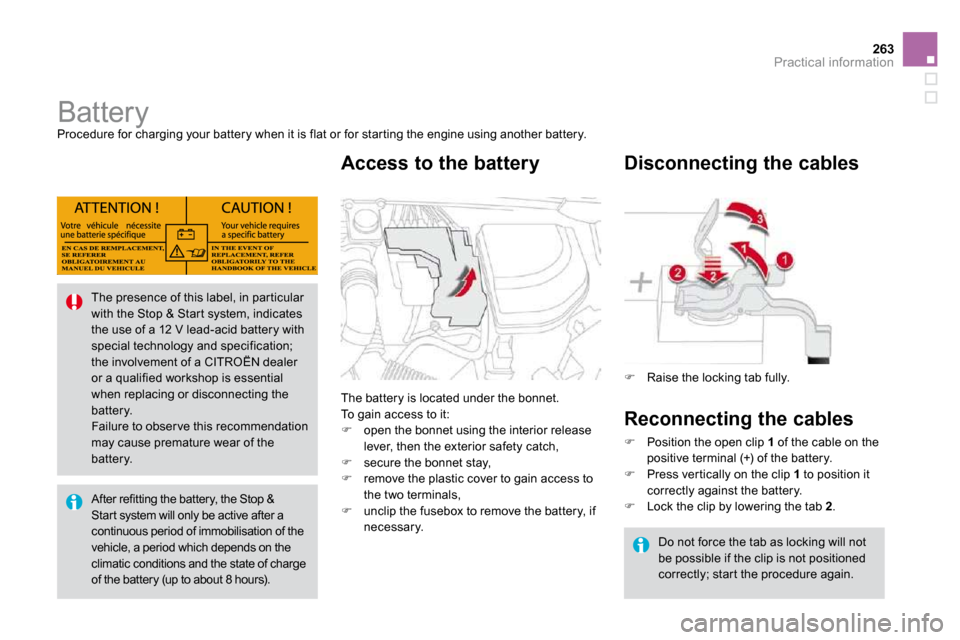charging Citroen DS4 2010.5 1.G Owner's Manual
[x] Cancel search | Manufacturer: CITROEN, Model Year: 2010.5, Model line: DS4, Model: Citroen DS4 2010.5 1.GPages: 341, PDF Size: 10.59 MB
Page 6 of 341

41Monitoring
Warning lampis onCauseAction/Obser vations
Batter y charge fixed. The battery charging circuit has a fault (dir ty or loose terminals, slack or cut alternator belt, ...).
The warning lamp should go off when the engine is star ted. If it does not go off, contact a CITROËN dealer or a qualified workshop.
Braking
fixed, associated with the STOP warning lamp.
The braking system fluid level has dropped significantly. You must stop as soon as it is safe to do so. Top up with brake fluid recommended by CITROËN. If the problem persists, have the system checked by a CITROËN dealer or a qualified workshop.
+
fixed, associated with the electric parking brake fault warning lamp, if the parking brake is released.
The braking system has a fault. You must stop as soon as it is safe to do so. Park, switch off the ignition and contact a CITROËN dealer or a qualified workshop.
+
fixed, associated with the STOP and ABS warning lamps.
The electronic brake force distribution (EBFD) system has a fault. You must stop as soon as it is safe to do so. Have it checked by a CITROËN dealer or a qualified workshop.
Page 161 of 341

For the airbags to be fully effective, observe the following safety rules:
Front airbags
Do not drive holding the steering wheel by its spokes or resting your hands on the centre par t of the wheel.
Passengers must not place their feet on the dashboard. If possible, do not smoke as deployment of the airbags can cause burns or the risk of injury from a cigarette or pipe. Never remove or pierce the steering wheel or hit it violently.
Lateral airbags
Use only approved covers on the seats, compatible with the deployment the lateral airbags. For information on the range of seat covers suitable for your vehicle, you can contact a CITROËN dealer (see "Practical information - § Accessories"). Do not fix or attach anything to the seat backs (clothing...). This could cause injury to the chest or arms if the lateral airbag is deployed. Do not sit with the upper par t of the body any nearer to the door than necessary.
Curtain airbags
Do not fix or attach anything to the roof. This could cause injury to the head if the cur tain airbag is deployed.
Do not remove the grab handles installed on the roof, they play a par t in securing the cur tain airbags.
Sit in a normal upright position. Wear a correctly adjusted seat belt. Do not leave anything between the occupants and the airbags (a child, pet, object...). This could hamper the operation of the airbags or injure the occupants. After an accident or if the vehicle has been stolen or broken into, have the airbag systems checked. All work on the airbag system must be carried out by a CITROËN dealer or a qualified workshop. Even if all of the precautions mentioned are obser ved, a risk of injury or of minor burns to the head, chest or arms when an airbag is deployed cannot be ruled out. The
bag inflates almost instantly (within a few milliseconds) then deflates within the same time discharging the hot gas via openings provided for this purpose.
Page 165 of 341

For the airbags to be fully effective, observe the following safety rules:
Front airbags
Do not drive holding the steering wheel by its spokes or resting your hands on the centre par t of the wheel.
Passengers must not place their feet on the dashboard. If possible, do not smoke as deployment of the airbags can cause burns or the risk of injury from a cigarette or pipe. Never remove or pierce the steering wheel or hit it violently.
Lateral airbags
Use only approved covers on the seats, compatible with the deployment the lateral airbags. For information on the range of seat covers suitable for your vehicle, you can contact a CITROËN dealer (see "Practical information - § Accessories"). Do not fix or attach anything to the seat backs (clothing...). This could cause injury to the chest or arms if the lateral airbag is deployed. Do not sit with the upper par t of the body any nearer to the door than necessary.
Curtain airbags
Do not fix or attach anything to the roof. This could cause injury to the head if the cur tain airbag is deployed.
Do not remove the grab handles installed on the roof, they play a par t in securing the cur tain airbags.
Sit in a normal upright position. Wear a correctly adjusted seat belt. Do not leave anything between the occupants and the airbags (a child, pet, object...). This could hamper the operation of the airbags or injure the occupants. After an accident or if the vehicle has been stolen or broken into, have the airbag systems checked. All work on the airbag system must be carried out by a CITROËN dealer or a qualified workshop. Even if all of the precautions mentioned are obser ved, a risk of injury or of minor burns to the head, chest or arms when an airbag is deployed cannot be ruled out. The
bag inflates almost instantly (within a few milliseconds) then deflates within the same time discharging the hot gas via openings provided for this purpose.
Page 235 of 341

263Practical information
Battery
Procedure for charging your battery when it is flat or for star ting the engine using another battery.
The battery is located under the bonnet. To gain access to it: � open the bonnet using the interior release lever, then the exterior safety catch, � secure the bonnet stay,
� remove the plastic cover to gain access to the two terminals, � unclip the fusebox to remove the battery, if necessary.
Access to the battery
� Raise the locking tab fully.
Disconnecting the cables
After refitting the battery, the Stop & Start system will only be active after a continuous period of immobilisation of the vehicle, a period which depends on the climatic conditions and the state of charge of the battery (up to about 8 hours).
The presence of this label, in par ticular with the Stop & Star t system, indicates the use of a 12 V lead-acid battery with special technology and specification; the involvement of a CITROËN dealer or a qualified workshop is essential when replacing or disconnecting the battery. Failure to obser ve this recommendation
may cause premature wear of the battery.
Reconnecting the cables
� Position the open clip 1 of the cable on the positive terminal (+) of the battery. � Press ver tically on the clip 1 to position it correctly against the battery. � Lock the clip by lowering the tab 2 .
Do not force the tab as locking will not be possible if the clip is not positioned correctly; star t the procedure again.
Page 236 of 341

� Connect the red cable to the positive terminal (+) of the flat battery A , then to the positive terminal (+) of the slave battery B . � Connect one end of the green or black cable to the negative terminal (-) of the slave battery B . � Connect the other end of the green or black cable to the ear th point C on the broken down vehicle.
� Operate the star ter, let the engine run. � Wait until the engine returns to idle and disconnect the cables.
Charging the battery using
a battery charger
The batteries contain harmful substances such as sulphuric acid and lead. They must be disposed of in accordance with regulations and must not, in any circumstances, be discarded with household waste. Take used remote control batteries and vehicle batteries to a special collection point.
� Disconnect the battery from the vehicle. � Follow the instructions for use provided by the manufacturer of the charger. �Reconnect starting with the negative terminal (-).� Check that the terminals and connectors are clean. If they are covered with sulphate (whitish or greenish deposit), remove them and clean them.
The Stop & Star t battery does not have to be disconnected for charging.
It is advisable to disconnect the battery if the vehicle is to be left unused for
more than one month.
Starting using another
battery